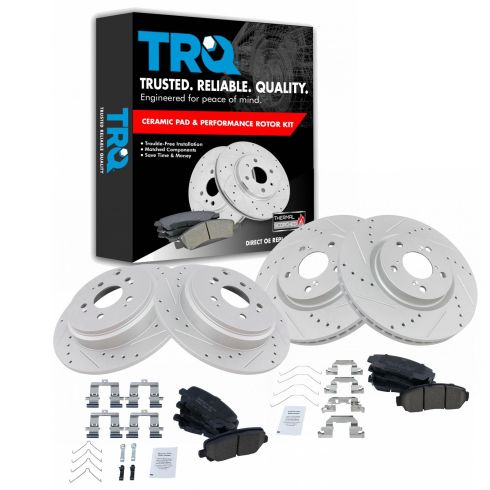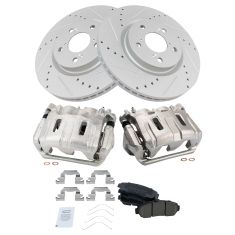1APBS00618-2011-14 Honda Odyssey Front & Rear Ceramic Performance Brake Pad & Rotor Kit TRQ Performance BKA12495

Replaces
2013 Honda Odyssey Front & Rear Ceramic Performance Brake Pad & Rotor Kit TRQ Performance BKA12495

Product Reviews
Loading reviews
4.95/ 5.0
20
20 reviews
Right parts for the job
October 17, 2018
All parts shipped were correct, shipped in a timely manner, and price was good. I highly recommended this kit
Priced right, fit perfectly
October 24, 2018
The items arrive early than promised, and everything is in excellent condition. The parts fit perfectly and the price is right. Would recommend this to everyone. The accompanying videos are excellent and easy to follow. Easy for DIYer like me to follow.
Satisfaction guaranteed!
June 11, 2019
I bought this kit for my 2014 Honda Odyssey. My brakes were grinding in the back, and wobbling in the front. It was time for a replacement and instead of $1400 at a dealership I bought these for a 5th of the cost. I had no problems installing these and the feel of the car is now amazing.
Great quality for the price
June 15, 2019
These brake and pad sets are a great value. Very nice quality for the price. Everything fit perfectly.
Brake and Rotor Bundle for Honda Odyssey 2012
December 17, 2020
Needed to change all of my rotors and pads on my Honda van and this kit was in my budget and had everything I wanted. Got them in, change them all out, and had absolutely no issues. This kit had everything you needed and the rotors and pads fit perfectly. After we were done my van had no more squeaking as well as the shaking while braking completely disappeared. This was a great product and 1A Auto even had videos on how to do everything on my exact vehicle. Honda Odyssey 2012 Touring.
Shuddering no more!
November 24, 2021
Shipping was quick, site easy to navigate. My wifes Honda Odyssey shuddered when braking. Rotors had been turned, pads replaced, 50k miles ago. Front rotors were shuddering again, these were more economical than going back with solid rotors as these will dissipate the heat.
Great performance kit!
December 28, 2021
Love this kit and online installation video! Price point and support is great as well.
No more Bad vibration
June 6, 2022
My 2012 have a slight variation when the brake heated up. I decided to buy this kit and replace the front and rear. This kit fit perfectly and is easy to install. Come with everything you need. Except fluid and brake cleaner. Took me less than 3 hours to install in my garage with hand tools. Make sure you flush the brake fluid. No more vibration and Stopping distance is greatly reduced. I only put about 900 miles of the rotors and pads so far. Only time will tell if it is worth the price over Genuine parts. I think it was a good decision to buy this kit. I recommend this kit if your Odyssey van is old and you intend to retired it in a few years.
Amazing!!!
September 16, 2022
I'm so glad I found this product at a very good price I really needed them once they were installed I felt the difference once driving.
Thank you!!!
Performance breaks
October 16, 2022
Great stopping power and smooth as butter.
Great Kit for 2012 Honda Odyssey
February 24, 2023
Great pads and rotors at a great price. Kit came super fast and installed without issues. Would recommend for anyone looking for good pads and rotors at a reasonable price. Skip the dealer and go this route.
May 25, 2023
Great product
Fast shipping
Thank you
satisfied
May 27, 2023
Out perform O.E.M. Odyssey rotors at a much better price.
Honda Odyssey Brakes
July 10, 2023
Great brakes. Easy to follow install video. Great price!
Great product
September 26, 2023
Great product!
Wow
April 9, 2024
Fit perfectly works great and looks good.
September 17, 2024
Very good quality and same as oem parts
Happy
October 1, 2024
Great parts quality?? thank you 1A auto
High quality brakes
October 9, 2024
Brakes were fantastic. How to video made installation easy to do myself. Saved me over $700! Kits were well organized and arrived early. Highly recommend!
October 21, 2024
Riding nice
Customer Q&A
No questions have been asked about this item.
Honda is a registered trademark of Honda Motor Co., Ltd. 1A Auto is not affiliated with or sponsored by Honda or Honda Motor Co., Ltd.
See all trademarks.
















